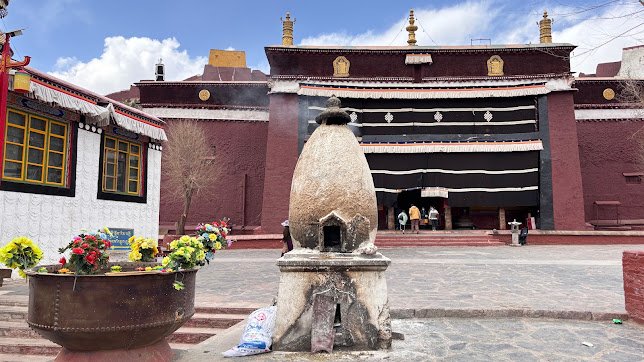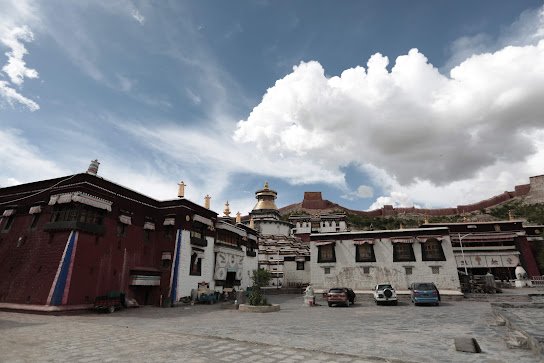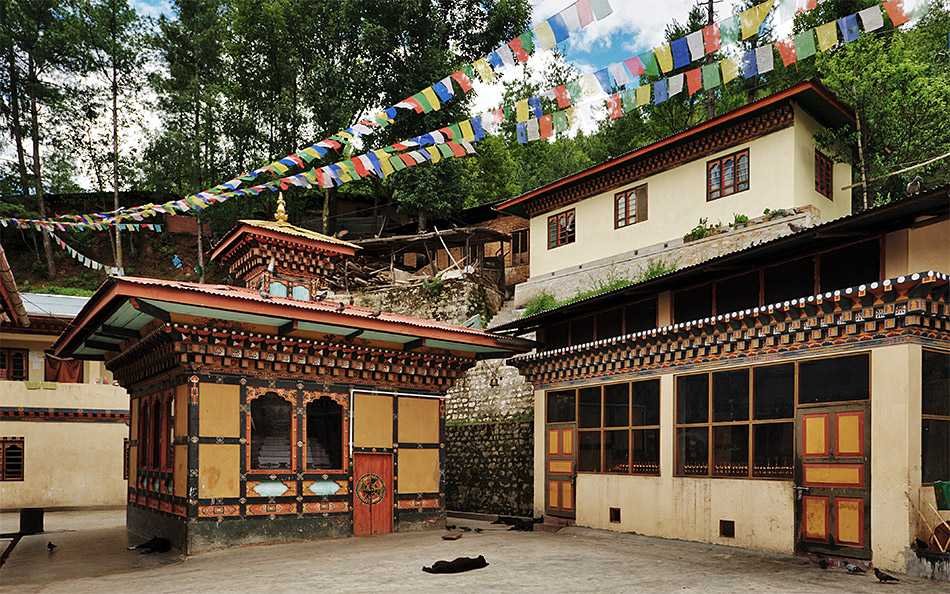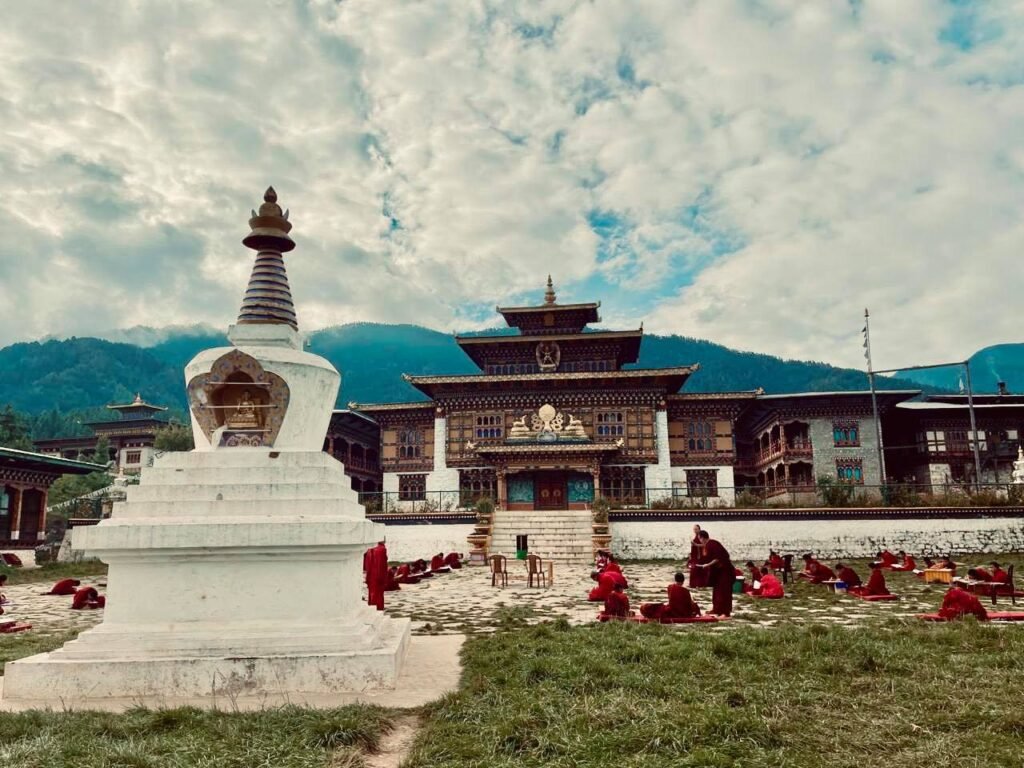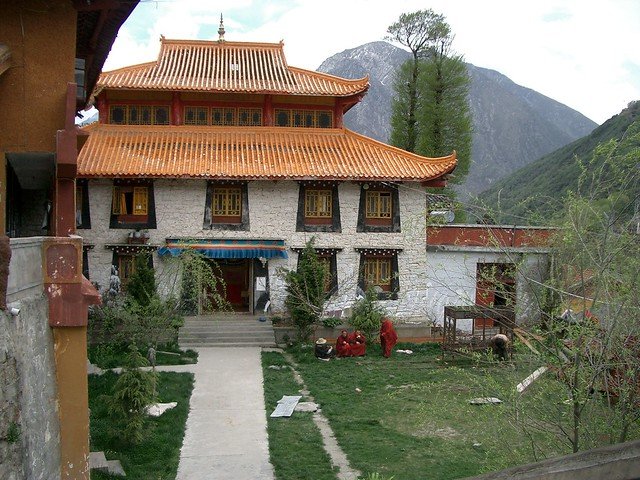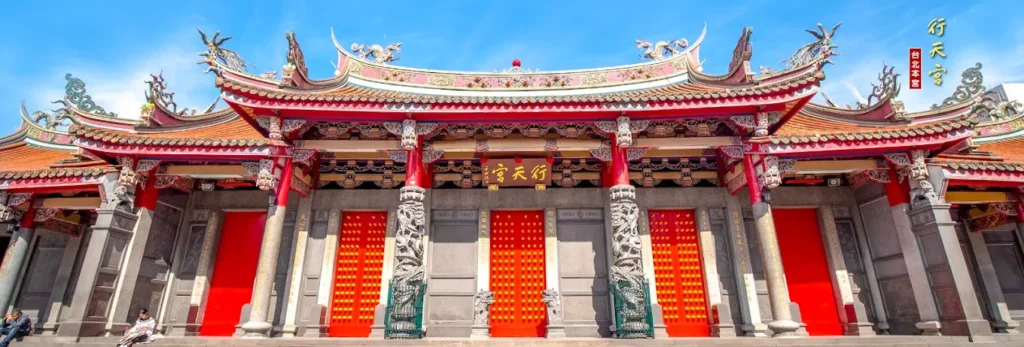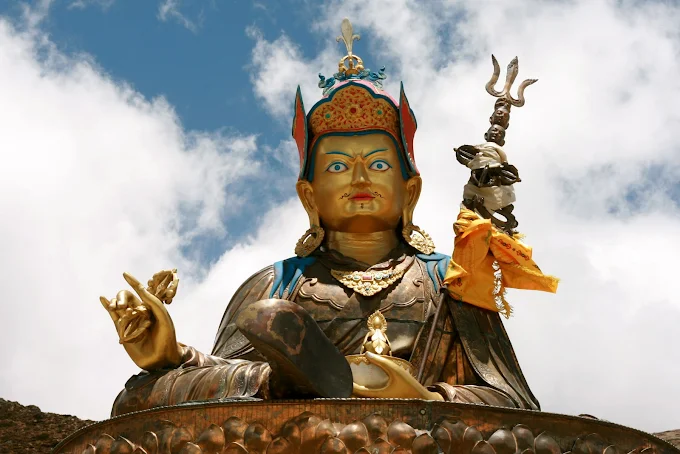Palcho Monastery (Baiju Temple): The Kumbum Stupa’s Multi-Sect Sanctuary
Palcho Monastery, known as Baiju Temple in Chinese, nestles in the heart of Gyantse, Tibet, radiating as a rare haven where Sakya, Kadampa, and Gelugpa sects coexist in spiritual harmony. Founded in 1418 by Rabten Kunsang Phak, this sacred site boasts the Kumbum Stupa, a nine-tiered architectural marvel with 108 chapels, housing thousands of Buddha statues and vibrant murals. Set at 3,900 meters, surrounded by Gyantse’s golden barley fields, Palcho’s red walls and blue tiles gleam under Tibet’s vast skies, captivating pilgrims and travelers. This immersive listing unveils Palcho’s essence, guiding you through its rich history, architectural splendor, sacred rituals, and practical visitor insights, offering a journey into a timeless jewel of Tibetan Buddhism.
The Unified Spirit of Palcho
Essence of Palcho Monastery (Baiju Temple)
Palcho Monastery, or Baiju Temple, pulses with a unique spiritual unity, blending three major Tibetan Buddhist sects—Sakya, Kadampa, and Gelugpa—under one sacred canopy. Established in 1418, it stands as a testament to inter-sect tolerance, its Kumbum Stupa symbolizing a cosmic mandala of enlightenment. The monastery’s vibrant frescoes and serene courtyards draw devotees seeking blessings amidst its sacred halls. Hidden in Gyantse’s valley, Palcho’s tranquil allure invites exploration of Tibet’s cultural depths.
- Spiritual Core: Rare coexistence of Sakya, Kadampa, Gelugpa sects.
- Iconic Feature: Kumbum Stupa with 108 chapels.
- Cultural Role: Beacon of Buddhist unity and artistry.
Historical Evolution
Palcho’s story began in 1418 when Rabten Kunsang Phak, a Gyantse prince, founded the monastery under royal patronage to foster sect harmony. By 1427, the Kumbum Stupa, built by artisans like Yaodan Gongsangpa and Khedrub Je, rose as a multi-sect masterpiece, taking a decade to complete. In 1904, the British invasion saw Palcho briefly occupied, with its halls repurposed, yet it endured with minimal loss. Restoration since 1977, funded by state grants, preserved its murals and statues, earning it a 1998 national cultural relic designation.
- Founding: Built in 1418 by Rabten Kunsang Phak.
- Kumbum Completion: Erected by 1427, a 10-year endeavor.
- Restoration: Revived since 1977, national relic in 1998.
Cultural Impact
Palcho’s multi-sect ethos shaped Tibetan Buddhism, promoting dialogue among Sakya, Kadampa, and Gelugpa traditions, a model for coexistence. Its Kumbum Stupa, with over 100,000 images, is a global art treasure, studied via HimalayanArt.org. The monastery’s role in Gyantse’s horse-racing festival preserves local culture, while its historical significance, including visits by the 14th Dalai Lama in 1957, resonates globally. Scholars cite its architecture in works like Michael Henss’ The Cultural Monuments of Tibet.
- Sect Harmony: Fosters inter-sect dialogue.
- Artistic Legacy: Kumbum’s images inspire global studies.
- Global Reach: Draws scholars, festival pilgrims.
Signature Legacy
The Kumbum Stupa, or “100,000 Pagoda,” is Palcho’s crowning glory, its nine tiers and 108 chapels forming a mandala-like path to enlightenment. Housing 3,000 Buddha statues and vibrant murals, it blends Indian and Nepalese styles, with lower floors Indian and upper tiers Nepalese. A legend speaks of a naga spirit’s conch shell hidden in the stupa’s golden spire, blessing its sanctity. This architectural marvel defines Palcho’s spiritual and artistic allure.
- Kumbum Stupa: Nine-tiered, 108-chapel mandala.
- Artistic Blend: Indian-Nepalese architectural fusion.
- Conch Shell Myth: Sacred relic in the spire.
Community and Global Reach
Locals cherish Palcho as Gyantse’s spiritual hub, offering prayers during festivals and life events. Its 76 monks—43 Gelugpa, 21 Sakya, 12 Kadampa—uphold its pluralistic ethos, guiding pilgrims. The Tibetan diaspora visits to reconnect, while international tourists, drawn by Trip.com and Tibet Tours, explore its halls. Palcho’s festivals and Kumbum’s art, featured on X posts, inspire global Buddhist communities.
- Local Devotion: Prayers for harvests, rituals.
- Monastic Diversity: 76 monks from three sects.
- Global Appeal: Attracts diaspora, tourists, scholars.
Architectural Splendor of Palcho
Distinctive Design
Palcho’s architecture, spanning 2,200 square meters at 3,900 meters, merges Tibetan, Nepalese, and Chinese influences, its red walls and blue tiles glowing against Gyantse’s hills. Centered on the Kumbum Stupa and Cuoqing Palace (main hall), it features a mandala-inspired layout, with 16 palace halls for sect-specific rituals. The enclosing wall, dotted with prayer wheels, guides pilgrims’ kora, reflecting Tsang’s 13th–15th-century temple style. This fusion creates a majestic yet accessible sanctuary.
- Style: Tibetan-Nepalese-Chinese architectural blend.
- Layout: Kumbum Stupa, Cuoqing Palace, 16 halls.
- Setting: Red walls amidst barley fields.
Signature Structures
The Kumbum Stupa, 42.4 meters high, dominates Palcho, its octagonal base and nine tiers housing 76 main chapels with deities like Tara and Manjushri. The Cuoqing Palace, a three-story hall, enshrines an 8-meter bronze Sakyamuni statue, restored after Cultural Revolution damage. The Juekang Chapel, with Ming Dynasty bodhisattva statues, glows under butter lamps, while the Zhuanjing Corridor’s prayer wheels invite devotion. These structures embody Palcho’s multi-sect grandeur.
- Kumbum Stupa: 76 chapels, 3,000 statues.
- Cuoqing Palace: 8-meter Sakyamuni statue.
- Juekang Chapel: Ming Dynasty bodhisattva statues.
Artisanal Mastery
Palcho’s murals, crafted by Nepalese and Tibetan artisans, use mineral pigments to depict Sakyamuni’s life and Gelugpa deities, their colors vivid after centuries. The Kumbum’s 3,000 statues, in clay, bronze, and gold, showcase sculptural finesse, with Chenresig’s gaze captivating pilgrims. Silk thangkas, including Ming Dynasty arhats, adorn halls, while carved wooden beams feature lotus motifs. These works, preserved through 1977 restoration, highlight Palcho’s artistic zenith.
- Murals: Nepalese-Tibetan frescoes, vibrant pigments.
- Statues: 3,000 clay, bronze, gold figures.
- Thangkas: Ming Dynasty silk artworks.
Hidden Architectural Gems
Palcho conceals subtle treasures within its halls. The Kumbum’s top platform, a circular overlook, offers sweeping views of Gyantse’s valley, framed by prayer flags. A faded mural in the Zhuanjing Corridor depicts the 1904 British invasion, a historical snapshot. The Cuoqing Palace’s upper balcony hides a rare Yamantaka thangka, accessible with monk permission. These details enrich Palcho’s sacred ambiance, inviting discovery.
- Top Platform: Valley views from Kumbum’s peak.
- Invasion Mural: Historical corridor artwork.
- Yamantaka Thangka: Hidden in Cuoqing balcony.
Preservation and Evolution
Preserving Palcho’s murals and statues requires constant care against Tibet’s harsh climate. Restoration since 1977, guided by state funds and UNESCO, used traditional pigments for frescoes and reinforced walls. The Sakyamuni statue’s 14-ton bronze was recast in 1979, blending modern techniques with ancient artistry. Ongoing efforts, supported by global donations, ensure Palcho’s legacy endures, despite erosion risks.
- Restoration: Pigments, wall reinforcements since 1977.
- Sakyamuni Recast: 14-ton bronze in 1979.
- Funding: UNESCO, global devotees.
Sacred Rites and Harmonious Traditions
Sacred Daily Rites
Each dawn, Palcho awakens with resonant chants, as monks from three sects gather in the Cuoqing Palace, their voices harmonizing with butter lamp glow. Pilgrims offer khatas (silk scarves) at the Sakyamuni statue, their prayers mingling with incense. Prayer wheels along the Zhuanjing Corridor hum, creating a meditative rhythm that envelops visitors in Palcho’s spiritual embrace.
- Chanting: Morning sutras in Cuoqing Palace.
- Offerings: Khatas at Sakyamuni statue.
- Ambiance: Incense, prayer wheel hum.
Unique Spiritual Practices
Palcho’s monks perform rituals reflecting its multi-sect ethos, blending Sakya’s Hevajra empowerments, Kadampa’s Atisha recitations, and Gelugpa’s Tara prayers. Pilgrims ascend the Kumbum’s tiers, visiting chapels in a mandala-like journey, believed to purify karma. The Juekang Chapel’s arhat blessings, unique to Palcho, draw devotees seeking wisdom. These practices, uniting sectarian traditions, deepen the monastery’s spiritual allure.
- Hevajra Empowerments: Sakya tantric rites.
- Kumbum Pilgrimage: Mandala-like chapel journey.
- Arhat Blessings: Wisdom-focused Juekang rites.
Vibrant Festival Traditions
Palcho’s festivals transform the monastery into a vibrant devotional hub. Saka Dawa, marking Buddha’s enlightenment, features mass kora walks and lamp offerings, with Cham dances by monks. The Gyantse horse-racing festival, held nearby, sees Palcho host prayers for archers and riders, uniting locals in celebration. Sharing tsampa (roasted barley) and butter tea fosters community spirit, echoing Tibet’s cultural pulse.
- Saka Dawa: Kora, Cham dances, lamp offerings.
- Horse-Racing Festival: Prayers for competitors.
- Community Role: Tsampa, tea shared.
Visitor Engagement
Visitors can offer khatas or light butter lamps at the Sakyamuni statue, guided by monks, immersing in Palcho’s spiritual life. Photography is permitted in the Kumbum for a 10-yuan fee, capturing murals’ vivid details, but flash is prohibited. Climbing the stupa’s tiers lets travelers join pilgrims, feeling Palcho’s sacred rhythm. Monks may share tales of the naga’s conch shell, enriching the experience.
- Offerings: Khatas, lamps with monk guidance.
- Photography: Kumbum shots, 10-yuan fee, no flash.
- Stupa Climb: Join pilgrims in tiered journey.
Monastic and Community Roles
Palcho’s 76 monks—43 Gelugpa, 21 Sakya, 12 Kadampa—maintain daily rites, study texts, and guide visitors, upholding its pluralistic ethos. They bless local harvests and life events, strengthening Gyantse ties. The monastery trains young monks in thangka painting, preserving artistry. This bond ensures Palcho remains a living spiritual center, fostering sect harmony.
- Monastic Duties: Rites, study, visitor guidance.
- Community Ties: Blessings for local events.
- Art Preservation: Thangka training.
Visiting Palcho Monastery (Baiju Temple)
Navigating to Palcho Monastery
Palcho lies in central Gyantse, 100 km southeast of Shigatse, along the Gyantse-Shigatse road, 230 km south of Lhasa. From Lhasa, a 260-km drive via the G318 highway takes 5 hours by bus or private tour vehicle, passing Shigatse. In Gyantse, the monastery is a 5-minute walk from the town center, marked by the Kumbum Stupa’s golden spire. Gyantse Castle, 800 meters away, guides the way.
- From Lhasa: 5-hour drive via Shigatse on G318.
- From Shigatse: 2-hour drive, 100 km northwest.
- Local Access: 5-minute walk from town center.
Address of Palcho Monastery
- Location: Gyantse Town, Gyantse County, Shigatse, Tibet Autonomous Region, China.
- Coordinates: 28.9333° N, 89.6667° E.
- Context: Central Gyantse, near castle and markets.
Visiting Hours and Etiquette
Palcho is open daily from 9:00 AM to 7:00 PM, with early visits offering quieter exploration. Dress modestly, covering shoulders and knees, and remove hats in chapels. Photography is allowed in the Kumbum for a 10-yuan fee; bring a flashlight for dim interiors and avoid flash. Respect pilgrims by maintaining silence and not touching relics or murals.
- Hours: 9:00 AM–7:00 PM, best in morning.
- Dress Code: Modest clothing, no hats in chapels.
- Etiquette: 10-yuan photo fee, no flash, silence.
Accessibility and Safety
Palcho’s main areas are accessible via paved paths, but the Kumbum’s upper tiers involve steep stairs, challenging for those with mobility issues. Wheelchair users need assistance; arrange with tour operators. Gyantse’s 3,900-meter altitude requires acclimatization; hydrate and rest to avoid sickness. The town is safe, but watch for festival crowds and stray dogs.
- Accessibility: Paved paths, steep stupa stairs.
- Mobility Aids: Limited, arrange assistance.
- Safety: Acclimatize, watch for crowds.
Amenities and Surroundings
Palcho offers restrooms and a small shop selling khatas and prayer beads. Gyantse’s markets, a 5-minute walk, serve momos (dumplings) and butter tea, immersing visitors in local flavors. The monastery’s courtyards, with prayer flags, provide serene reflection spots. Gyantse’s old town, buzzing with shops and teahouses, offers souvenirs and views of the castle.
- Amenities: Restrooms, small shop.
- Food: Markets with momos, tea.
- Surroundings: Courtyards, vibrant old town.
Immersive Visitor Tips
Arrive at dawn to hear monks chanting in the Cuoqing Palace, their voices echoing through the hall, setting a meditative tone. Photograph the Kumbum’s murals from the seventh tier with a flashlight for vivid detail, paying the 10-yuan fee. Walk the kora at dusk, when the castle glows golden, enhancing Palcho’s ambiance. Savor momos in Gyantse’s markets, chatting with locals about the Kumbum’s legends for cultural depth.
- Dawn Visits: Hear chants in Cuoqing Palace.
- Photography: Seventh tier for mural shots, 10-yuan fee.
- Evening Kora: Castle views at dusk.
